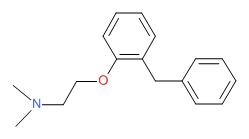NCBI Bookshelf. A service of the National Library of Medicine, National Institutes of Health.
LiverTox: Clinical and Research Information on Drug-Induced Liver Injury [Internet]. Bethesda (MD): National Institute of Diabetes and Digestive and Kidney Diseases; 2012-.

LiverTox: Clinical and Research Information on Drug-Induced Liver Injury [Internet].
Show detailsOVERVIEW
Introduction
Phenyltoloxamine is a first generation antihistamine that is used for symptoms of the common cold and as a short acting sedative. Phenyltoloxamine has not been linked to instances of clinically apparent acute liver injury.
Background
Phenyltoloxamine (fen" il tol ox' a meen) is a first generation antihistamine that is used to treat the symptoms of the common cold, including sneezing, cough, runny note, watery eyes and itching. Because of its sedating side effects, it is also used as a mild sleeping aid and sedative. Phenyltoloxamine belongs to the ethanolamine class of antihistamines (with clemastine and dimenhydrinate) and is currently used largely in combination with other agents such as phenylephrine and acetaminophen in over-the-counter products for relief of symptoms of the common cold and nighttime relief of minor aches and pains. Representative brand names of products that include phenyltoloxamine include Dologesic and Relagesic. The typical adult oral dose is 30 to 50 mg. Common side effects include sedation, impairment of motor function, confusion, dizziness, blurred vision, dry mouth and throat, palpitations, tachycardia, abdominal distress, constipation and headache. Antihistamines can worsen urinary retention and glaucoma.
Hepatotoxicity
Like most first generation antihistamines, phenyltoloxamine has not been linked to liver test abnormalities or to clinically apparent liver injury. The reason for its safety may relate its short half-life and limited duration of use.
References on the safety and potential hepatotoxicity of antihistamines are given together after the Overview section on Antihistamines.
Likelihood score: E (unlikely to be a cause of clinically apparent liver injury).
Drug Class: Antihistamines
PRODUCT INFORMATION
REPRESENTATIVE TRADE NAMES
Phenyltoloxamine – Dologesic®, Relagesic®
DRUG CLASS
Antihistamines
Product labeling at DailyMed, National Library of Medicine, NIH
CHEMICAL FORMULA AND STRUCTURE
| DRUG | CAS REGISTRY NUMBER | MOLECULAR FORMULA | STRUCTURE |
|---|---|---|---|
| Phenyltoloxamine | 92-12-6 | C17-H21-N-O |
 |
- Review Doxylamine.[LiverTox: Clinical and Researc...]Review Doxylamine.. LiverTox: Clinical and Research Information on Drug-Induced Liver Injury. 2012
- Review Triprolidine.[LiverTox: Clinical and Researc...]Review Triprolidine.. LiverTox: Clinical and Research Information on Drug-Induced Liver Injury. 2012
- Review Clemastine.[LiverTox: Clinical and Researc...]Review Clemastine.. LiverTox: Clinical and Research Information on Drug-Induced Liver Injury. 2012
- Review Carbinoxamine.[LiverTox: Clinical and Researc...]Review Carbinoxamine.. LiverTox: Clinical and Research Information on Drug-Induced Liver Injury. 2012
- Review Diphenhydramine.[LiverTox: Clinical and Researc...]Review Diphenhydramine.. LiverTox: Clinical and Research Information on Drug-Induced Liver Injury. 2012
- Phenyltoloxamine - LiverToxPhenyltoloxamine - LiverTox
Your browsing activity is empty.
Activity recording is turned off.
See more...